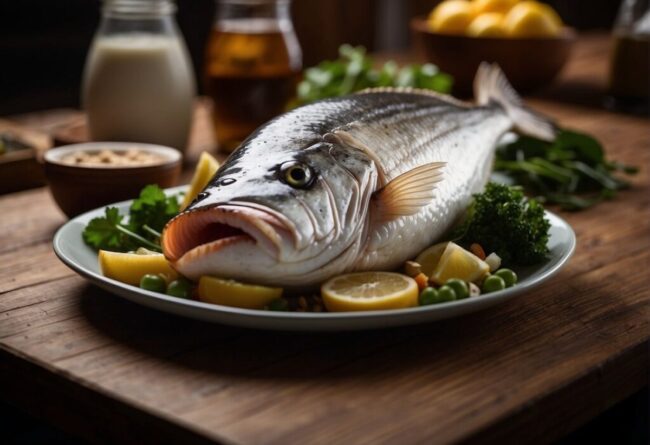7 Delicious Halibut Substitutes for Any Meal
Halibut substitutes allow seafood lovers to enjoy similar textures and flavors when this firm fish isn't available.
Some options offer the same mild sweetness, while others bring a slightly richer or leaner profile.
Cooking methods like grilling, baking, or pan-searing influence the best choice.
Finding the right alternative ensures that recipes turn out just as delicious.
Understanding Halibut
Halibut is a firm, mild white fish prized for its delicate flavor. It is commonly used in grilling, roasting, and pan-searing recipes.
Halibut Features Explained
Halibut features a dense and flaky flesh that appeals to both seafood lovers and newcomers alike.
The mild flavor acts as a blank slate, allowing chefs to experiment with an array of herbs and spices without overwhelming the palate.
Thick, meaty fillets lend themselves well to grilling, baking, or pan-searing techniques.
Packed with protein and omega-3 fatty acids, this fish supports heart health while providing essential nutrients for overall wellness.
Whether served in a gourmet dish or simply seasoned with lemon and salt, halibut stands ready to impress at any meal.
Halibut Cooking Ideas
Halibut shines in various cooking methods, offering a delightful experience no matter how it’s prepared.
Baking locks in moisture and highlights its gentle flavor, perfect for those who appreciate subtlety.
Frying creates a crispy exterior that contrasts beautifully with the tender flesh inside.
Grilling adds an enticing smoky essence that elevates the dish to new heights.
This fish adapts seamlessly to both intricate recipes and straightforward meals, proving itself as a versatile choice for any occasion.
Best Fish Replacements for Halibut
Fish substitutes for halibut offer similar textures and mild flavors, making them ideal for various seafood dishes. They maintain the delicate taste while providing flexibility in recipes.
Cod
Cod features a delightful, flaky texture that adds an appealing element to any dish.
Its sweet and mild flavor makes it a fantastic alternative to halibut, easily fitting into various culinary creations.
You can use this fish in numerous recipes, from simple pan-seared preparations to more complex casseroles.
This versatility opens doors for creativity in the kitchen while ensuring satisfying meals every time.
Cod’s adaptability means you can experiment with different seasonings and cooking methods without overwhelming its natural taste.
Haddock and Its Relatives
Haddock offers a delightful balance of flavor and texture, much like halibut.
This cold-water fish shines when baked or fried, ensuring a satisfying bite every time.
Its firm flesh holds up beautifully during cooking, making it versatile for various dishes.
A subtle sweetness enhances its appeal, inviting experimentation with different seasonings and sauces.
Enjoying haddock can elevate any meal while providing an excellent source of lean protein that supports a healthy diet.
Other Types of Flatfish
Flounder offers a tender bite with its flat body, closely resembling halibut in appearance.
The delicate flavor enhances any dish without overpowering other ingredients.
Sole features a refined texture that makes it an excellent alternative to halibut, allowing for versatile cooking methods.
Both fish provide mild tastes that pair beautifully with various sauces and sides.
Choosing either can elevate your meal while introducing subtle seafood flavors to your palate.
Tilapia
Tilapia stands out as an accessible seafood choice, appealing to many budgets without sacrificing taste.
Its mild flavor allows for versatility in cooking, fitting seamlessly into various cuisines and recipes.
Packed with protein and omega-3 fatty acids, this fish contributes positively to a balanced diet.
You can easily incorporate it into your meals whether grilled, baked, or sautéed.
Choosing tilapia means enjoying nutritious food that doesn’t break the bank while adding delicious options to your menu.
Sea Bass & Turbot
Striped bass brings a satisfying bite, ideal for outdoor grilling.
Its resilience allows for bold seasoning and various cooking methods without losing its shape.
Turbot captivates with a luxurious taste, often found in gourmet dishes.
This fish features a dense texture that holds up beautifully under sauces and herbs.
Both options elevate any dining experience with their distinct flavors and culinary versatility.
Non-Fish Replacement Options
Non-fish alternatives bring diverse flavors and textures to seafood-inspired meals. They cater to different dietary preferences while maintaining a satisfying bite.
Chicken and Pork
Chicken breast offers a mild taste and firm texture that can closely resemble halibut when prepared correctly.
Poaching or steaming helps maintain its moisture, ensuring each bite feels tender.
To elevate the flavor, consider using a citrus or herb marinade; this adds brightness similar to what halibut provides.
On the other hand, pork tenderloin presents a heartier option with its lean cut and robust character.
Roasting or pan-frying it with light seasoning allows for versatility, while incorporating herbs like dill or tarragon can replicate those classic flavors often associated with halibut dishes.
Veggie and Vegan Choices
Firm tofu serves as a versatile ingredient that easily absorbs flavors, mimicking the texture of fish beautifully.
Pressing and baking or pan-frying gives it a delightful crust, elevating its appeal.
A marinade made with seaweed or kelp powder, lemon juice, and salt infuses this protein with ocean-like notes that transport your palate to coastal delights.
King oyster mushrooms provide another fantastic alternative; their meaty consistency stands in for seafood remarkably well.
Sautéing them until golden while seasoning with soy sauce, garlic, and a hint of vinegar enhances their natural umami richness perfectly.
Best Alternatives to Halibut
The best alternatives to halibut include other mild white fish like cod, flounder, or haddock. These options provide similar texture and taste.
Substitution Requirements
Choosing a substitute for halibut requires careful thought about its texture and flavor.
The ideal alternative should offer a firm consistency, similar to that of halibut, ensuring the dish holds together well.
A mild taste is equally important; this allows the other ingredients to shine without overpowering them.
Versatility in cooking methods also plays a role; whether you prefer grilling or baking, your substitute must be able to withstand heat without losing its appeal.
Exploring options like cod or tilapia can lead you to satisfying results while keeping your meal balanced and enjoyable.
Preparing Halibut Substitutes
Preparing halibut substitutes requires adjusting cooking times and seasonings. Choosing the right method ensures a tender and flavorful result.
Halibut Cooking Alternatives
Cooking fish offers a variety of techniques that enhance flavor and texture.
Pan-searing creates a delightful golden crust, perfect for cod or flounder, adding depth to your dish.
Steaming retains moisture beautifully in delicate fish like flounder and sole, resulting in tender bites that melt in your mouth.
Frying provides a satisfying crunch; tilapia or cod fillets coated lightly with seasoned flour can elevate any meal with their crispy exterior.
Baking works wonders for firmer varieties such as striped bass; the heat allows flavors to meld while keeping the flesh flaky and light.
Flavoring and Soaking
Halibut has a gentle flavor that works beautifully with basic seasonings.
A sprinkle of salt and pepper can elevate its taste, while a splash of lemon juice adds brightness.
Fresh herbs such as dill or parsley bring an aromatic touch without overwhelming the dish.
Marinating the fish in olive oil mixed with garlic and herbs for about 30 minutes allows flavors to meld perfectly, creating a richer profile.
Experimenting with various seasonings opens up new dimensions in each bite, enhancing your culinary experience effortlessly.
Nutritional Differences
Different fish have varying nutritional profiles, with some offering more omega-3s or protein. Comparing nutrients helps in selecting the healthiest option.
Protein and Omega-3 Levels
Halibut shines with its impressive nutritional profile, featuring high-quality protein and beneficial omega-3 fatty acids.
A single serving packs a punch, delivering around 22 grams of protein alongside heart-healthy fats that support brain function.
Cod, flounder, and sole serve as excellent alternatives; they still offer solid protein levels while being slightly lower in omega-3s.
Striped bass and mahi mahi hold their own too, providing comparable amounts of protein to halibut with moderate omega-3 benefits.
Opting for these fish can enhance your meals while contributing valuable nutrients to your diet.
Calories and Fat Overview
Halibut stands out as a low-calorie choice, offering just 115 calories and 2.5 grams of fat per 3-ounce serving.
Flounder and sole closely follow, each providing about 2 grams of fat and fewer than 100 calories.
Cod takes the lead in leanness with only around 90 calories and less than a gram of fat in the same serving size.
Striped bass and mahi mahi bring slightly higher calorie counts while still fitting into a low-fat category perfectly.
These fish not only keep your diet light but also deliver essential nutrients like selenium and vitamin B12 for overall wellness.




